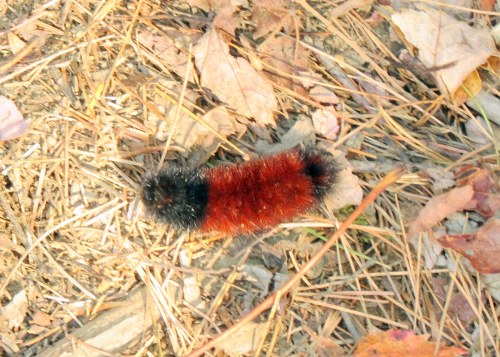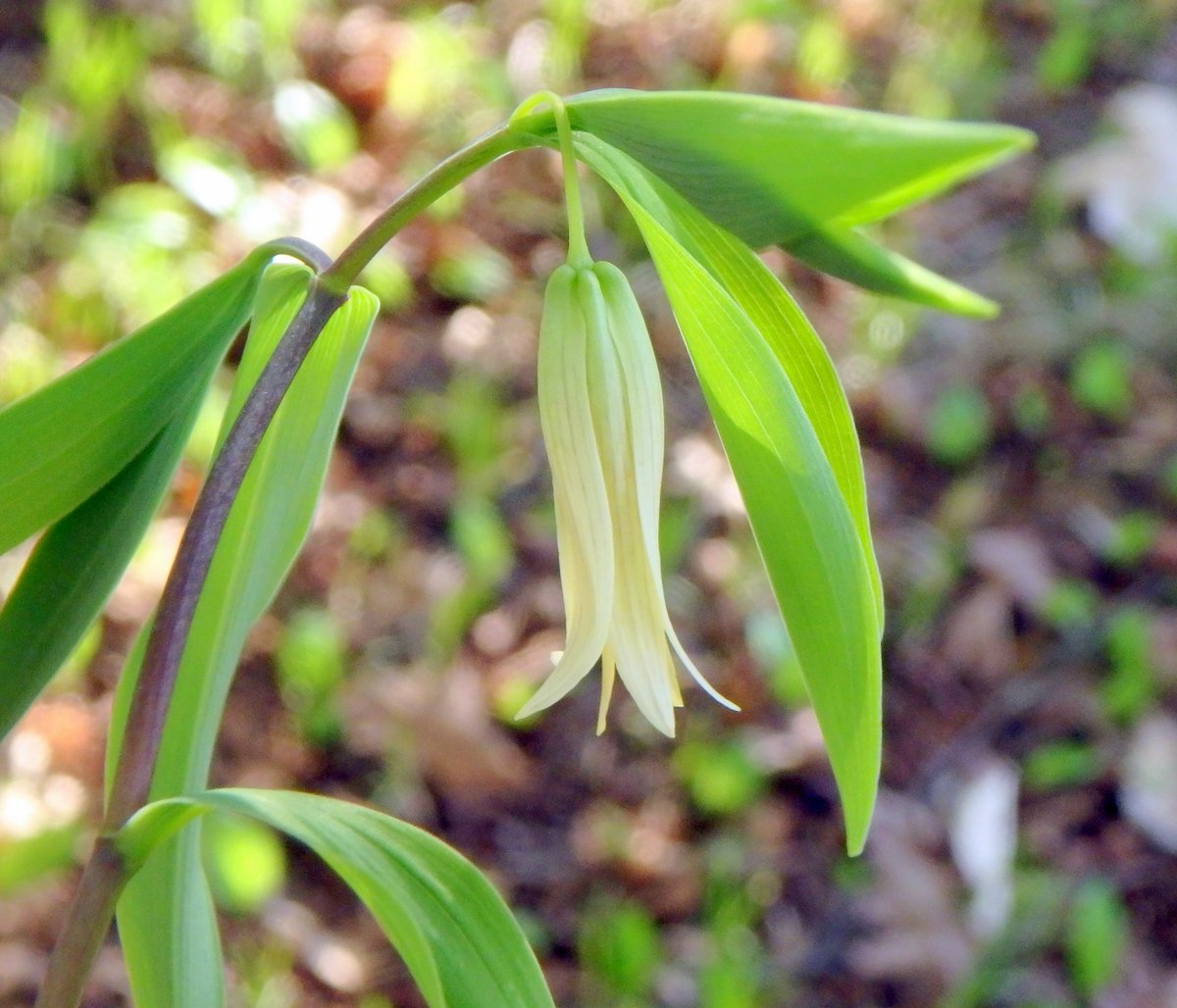Last Saturday was supposed to be a gorgeous day according to the weather people so I headed out early for Pitcher Mountain in Stoddard. In my opinion no other mountain can compare for foliage viewing, because this one has a 360 degree view. By the time I got there though, the parking area was filled so I had to park on the road. The view above is what I saw on the other side.
I always take a photo of the trail so you can at least get an idea of my surroundings but on this climb I had to fiddle faddle around while the people ahead of me turned the corner. But they didn’t turn the corner right away because they were taking photos-of all things, the bits of nature all around them that caught their eyes. I gave them a silent hooray and shot the side of the trail instead. Even then they still made it into the shot but oh well, now you know there were people there. A lot of people.
Lady ferns were turning white as they always do in fall. Besides sensitive fern it’s one of the earliest to do so.
Clubmosses were clubbing, just as they do every year at this time. Their spores form in spike-like structures called sporophylls, which are the yellowish green “clubs” seen here. A single clubmoss plant can take twenty years to grow from a spore, so I try to never harm them.
I turned to look at Mount Monadnock and saw the haze, present for weeks now, from the western wildfires. If you look at satellite imagery you can sometimes see a trail of smoke from the Pacific to the Atlantic.
I knew that the haze meant that It wouldn’t be a day for far off views but when the near views looked like this I had a hard time caring.
The farmer had baled all the hay, I’m guessing for the Scottish Highland cattle that live here. Do they live this high up in Scotland? I wondered. I’ve often thought they had the best view of anybody.
I moved aside to let people by and fell in a small hole off the side of the trail. I could have twisted my ankle if I hadn’t had good stout hiking boots on, and it reminded me how easy it is to get hurt on rough trails like this. Each year the New Hampshire Department of Fish and Game goes on average 190 rescue missions, which costs the state about $308,952 per year. Because of this they have started charging the people who have had to be rescued due to their own negligence. An example of negligence would be climbing this trail without proper footwear and in the winter without proper winter clothing. I’ve been up here in January and it’s no joke.
I’ve seen people climbing this trail in flip flops believe it or not, and that’s their choice but if they get hurt and have to be carried from the mountain, they will be charged for the adventure. The elderly and children who get lost are not charged and neither are those who have a medical emergency, but being foolish in the woods here in New Hampshire could cost you a few hundred dollars.
I won’t tell you how many times I have tried and failed at this photo but today the light was just right and I finally got it. What is it? It shows what black knot disease can do to a cherry tree. Black knot is caused by the fungus Apiosporina morbosa which can also attack plums, peaches, and apricots. Spores from the fungus can be spread by rain or wind and typically infect trees from April through June on new growth.
This photo I took previously shows what black know looks like on a young tree. Infected stems swell up and produce hard black knots which will eventually become serious wounds like that seen in the previous photo. This disease can eventually kill the tree so infected limbs should be pruned off 2-4 inches below the knots and buried or burned before bud break the following spring.
The blackberries have taken on their beautiful fall purple and bronze colors. You have to just stand for a moment or two admiring them because they’re so pretty.
There were lots of leaves still on the maples, even though many have fallen in the lowlands. It has most likely been warmer up here because cold air flows like a stream down mountainsides and pools in the valleys below. Since I live in a valley I tend to notice it more.

I saw a dead staghorn sumac and had to have a look at the bark, because the inner bark of the tree is often bright red as this example was. I’ve read that the powdered bark can be made into a good antiseptic salve that can be used to treat burns.
I was out of breath by the time I saw the fire tower from the old ranger cabin, so I decided to sit for a spell.
I was sitting on the porch and heard “Oh cool! What is that?” I stood up and saw 4 or 5 young boys, probably just into their teens. “It’s the ranger station,” I told them. “Does anyone live there? Can we go inside?” I answered no to both questions. “But you can stand on the porch,” I said as I moved along. Of course they raced down the trail and did just that. I remembered when I could race down trails. And up them.
The old mountain ash had not only been stripped of all its fruit by birds, the wind had taken all its leaves as well. Now it’s ready for its winter sleep.
There was that smoky, yellowy haze again and I thought of the poor people in the western part of the country. We had a terrible fire here once; in April of 1940, in the most destructive forest fire to ever strike this part of the state twenty seven thousand acres burned, including the fire tower and all of the trees and vegetation on the summit. Terrible it was, but it was nothing like what is happening on the west coast.
The colors at the summit were beautiful, especially the deep reds of the blueberries.
Speaking of blueberries, Josh Fecteau from the Josh’s Journal blog over there in the favorite links section asked me to take another look at what I identified as the native black highbush blueberry (Vaccinium fuscatum.) The berries I looked at this time were in the center of this bush, which by its leaves I know is the highbush blueberry bush (Vaccinium corymbosum.) The problem is, all of the various species of bushes grow in a tangled thicket so it can be difficult to know what you’ve got.
Josh thought these might instead be the fruit of the Chokeberry (Aronia sp.) and I have to say that they don’t look quite right for a blueberry, so I think he’s correct. Personally I don’t get too excited about such things but I know Josh is a forager and such things are very important to foragers, so his intentions and motivations are good ones. Though I have been studying nature since I was a boy and have had some formal training in botany I still consider myself very much an amateur, because there is simply too much to know. I’ve met a few in life who thought they knew it all but so far in my experience none has, and that includes me. I do make mistakes and people should always verify any plant identification they find on this blog if they intend to use that plant in any way.
The sun was coming directly at me when I tried for this shot of the meadows below.
I had to wait for a few people to move on before I could get a good view of what I call the near hill. It was beautiful; well worth waiting for. Just an endless, unbroken forest of color stretching off to the horizon.
A 4.8 million square mile forest of color.
If there was a triangle in the center of this marker it would be part of a triangulation point but since there isn’t it’s there for a surveyor to know where the point of his plumb bob should fall to be dead accurate. Right on that cross in the very center I’d guess, or maybe over the tiny hole I’ve never noticed before.
I don’t know this lichen’s name and I don’t really care. It’s beauty and the challenge of getting its photo was enough.
The overhead wire that I accidentally got in this shot is one of the cables that keeps the fire tower from blowing off the top of mountain.
And I’m not kidding. On this day it was extremely windy and there were a couple of gusts that almost blew me over. You’d have thought it was January.
Wind is to be expected up here, sometimes very strong winds, but on this day it didn’t really bother me because I was lost in the colors.
The ferns wanted attention and they had mine.
It had rained a bit during the past week but it was enough to top off what I call the bird bath, apparently. In fact I’ve never seen it go dry, and that’s a little amazing. I sat for a while hoping a bird would stop in to bathe or drink but none came. It didn’t matter; it was a glorious day with filled with sunshine and incredible beauty everywhere I looked, and I knew that I lacked not one single thing. You really can’t ask for more than that.
I saw a wooly bear caterpillar on the trail. Folklore says that the wider the orangey brown band on a wooly bear caterpillar is, the milder the winter will be. If we’re to believe it then this winter will be very mild indeed. Wooly bears don’t care much about winter though, because they produce their own antifreeze and can freeze solid. Once the temperature rises into the 40s F in spring they thaw out and begin feeding on dandelion and other early spring greens. Eventually they spin a cocoon and emerge as a beautiful tiger moth. From that point on it has only two weeks to live but I’d bet that it lives a rich, full and satisfying life.
The last time I was up here in August the backs of my legs were bothering me enough so I was a little apprehensive about the trip down but on this trip they felt fine. I didn’t fly down the trail to catch up with the people you see there ahead of me but I did okay.
If the sight of the blue skies fills you with joy, if a blade of grass springing up in the fields has power to move you, if the simple things in nature have a message you understand, rejoice, for your soul is alive. ~Eleanora Duse
Thanks for stopping in.





















































































































































































































